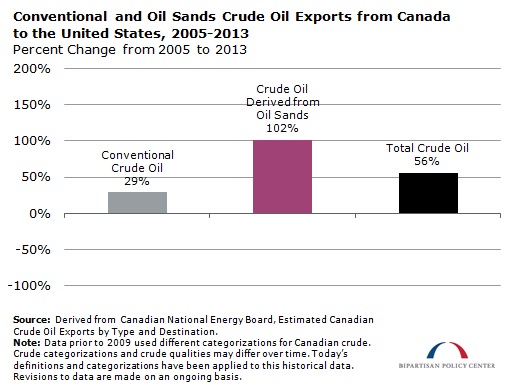U.S. Imports of Canadian Oil Sands Have Doubled Since 2005
Although total U.S. imports of crude oil have declined 24 percent from their peak in 2005, imports of crude oil from Canada have increased 56 percent during that period. Canadian oil sands were the largest driver of the increase, doubling since 2005. The United States imports more crude oil from Canada than any other country?Canada accounted for 33 percent of total U.S. imports of crude oil in 2013.

U.S. imports of crude oil from Canada grew from 1.6 million barrels per day (bbl/d) in 2005 to 2.5 million bbl/d in 2013, according to data from Canada’s National Energy Board. In those same years, U.S. imports of Canadian crude oil derived from oil sands increased from roughly 0.6 million bbl/d to 1.2 million bbl/d, which accounts for about 60 percent of Canada’s total oil sands production each year during that period. For comparison, the planned capacity of the Keystone XL pipeline is 0.83 million bbl/d.
Oil sands are deposits of bitumen in sand or porous rock. Bitumen?a mixture of hydrocarbons that, at normal temperatures and pressures, is a solid or semisolid, tarlike substance?is targeted in oil-sand extraction. Since bitumen does not ?ow under ambient conditions, it must either be upgraded into synthetic crude or mixed with lighter weight crude oil to form blended bitumen before it can be transported via pipeline.

Crude oil derived from oil sands were the fastest growing category of Canadian crude exports to the United States from 2005 to 2013, growing by 102 percent. Imports of conventional crude oil from Canada grew by 29 percent during this same period.
According to data from Canada’s National Energy Board, the majority of exports of Canadian crude oil are transported to the United States via existing pipelines. While rail transport has garnered significant media and public attention for its rapid growth in the past two years, rail exports from Canada accounted for less than 5 percent of total crude oil exports in 2013. Canadian energy producers estimate that current pipeline capacity will reach saturation as soon as this year, which will increase the incentives to add additional pipeline and rail capacity.
Share
Read Next
Support Research Like This
With your support, BPC can continue to fund important research like this by combining the best ideas from both parties to promote health, security, and opportunity for all Americans.
Give NowRelated Articles
Join Our Mailing List
BPC drives principled and politically viable policy solutions through the power of rigorous analysis, painstaking negotiation, and aggressive advocacy.